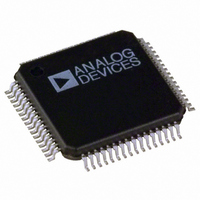ADE7166ASTZF8 Analog Devices Inc, ADE7166ASTZF8 Datasheet - Page 120

ADE7166ASTZF8
Manufacturer Part Number
ADE7166ASTZF8
Description
IC ENERGY METER 1PHASE 64LQFP
Manufacturer
Analog Devices Inc
Specifications of ADE7166ASTZF8
Applications
Energy Measurement
Core Processor
8052
Program Memory Type
FLASH (8 kB)
Controller Series
ADE71xx
Ram Size
512 x 8
Interface
I²C, SPI, UART
Number Of I /o
20
Voltage - Supply
3.135 V ~ 3.465 V
Operating Temperature
-40°C ~ 85°C
Mounting Type
Surface Mount
Package / Case
64-LQFP
Ic Function
Single Phase Energy Measurement IC
Supply Voltage Range
3.13V To 3.46V, 2.4V To 3.7V
Operating Temperature Range
-40°C To +85°C
Digital Ic Case Style
LQFP
No. Of Pins
64
Lead Free Status / RoHS Status
Lead free / RoHS Compliant
Available stocks
Company
Part Number
Manufacturer
Quantity
Price
Company:
Part Number:
ADE7166ASTZF8
Manufacturer:
Analog Devices Inc
Quantity:
10 000
Company:
Part Number:
ADE7166ASTZF8-RL
Manufacturer:
Analog Devices Inc
Quantity:
10 000
ADE7566/ADE7569/ADE7166/ADE7169
Take care when changing the interval timer time base. The
recommended procedure is as follows:
1.
2.
3.
4.
The RTC alarm event wakes the 8052 MCU core if the MCU is
in PSM2 when the alarm event occurs.
RTC CALIBRATION
The RTC provides registers to calibrate the nominal external
crystal frequency and its variation over temperature. A frequency
error up to ±248 ppm can be calibrated out by the RTC circuitry,
which adds or subtracts pulses from the external crystal signal.
The nominal crystal frequency should be calibrated with the
RTC nominal compensation register so that the clock going into
the RTC is precisely 32.768 kHz at 25°C. The RTC Temperature
Compensation SFR (TEMPCAL, 0xF7) is used to compensate
for the external crystal drift over temperature by adding or
subtracting additional pulses based on temperature.
The LSB of each RTC compensation register represents a
±2 ppm frequency error. The RTC compensation circuitry adds
the RTC Temperature Compensation SFR (TEMPCAL, 0xF7)
and the RTC Nominal Compensation SFR (RTCCOMP, 0xF6)
to determine how much compensation is required. Note that
the sum of these two registers is limited to ±248 ppm.
Calibration Flow
A RTC calibration pulse output is provided on the P0.2/CF1/
RTCCAL pin. Enable the RTC output by setting the RTCCAL
bit in the Interrupt Pins Configuration SFR (INTPR, 0xFF).
The RTC calibration is accurate to within ±2 ppm over a 30.5
second window in all operational modes: PSM0, PSM1, and
PSM2. Two output frequencies are offered for the normal RTC
If the Alarm Interval SFR (INTVAL, 0xA6) is going to
be modified, write to this register first. Then, wait for
one 128 Hz clock cycle to synchronize with the RTC,
64,000 cycles at a 4.096 MHz instruction cycle clock.
Disable the interval timer by clearing the ITEN bit in the
RTC Configuration SFR (TIMECON, 0xA1). Then, wait
for one 128 Hz clock cycle to synchronize with the RTC,
64,000 cycles at a 4.096 MHz instruction cycle clock.
Read the TIMECON SFR to ensure that the ITEN bit is
clear. If it is not, wait for another 128 Hz clock cycle.
Set the time-base bits (ITS[1:0]) in the TIMECON SFR to
configure the interval. Wait for a 128 Hz clock cycle for this
change to take effect.
Rev. A | Page 120 of 144
mode: 1 Hz with FSEL[1:0] = 00 and 512 Hz with FSEL[1:0] =
01 in the Interrupt Pins Configuration SFR (INTPR, 0xFF).
A shorter window of 0.244 seconds is offered for fast calibration
during PSM0 or PSM1. Two output frequencies are offered for
this RTC calibration output mode: 500 Hz with FSEL[1:0] = 10
and 16.384 kHz with FSEL[1:0] = 11 in the INTPR SFR. Note
that for the 0.244 second calibration window, the RTC is
clocked 125 times faster than in normal mode, resulting in
timekeeping registers that represent seconds/125, minutes/125,
and hours/125 instead of seconds, minutes, and hours.
Therefore, this mode should be used for calibration only.
Table 130. RTC Calibration Options
Option
Normal Mode 0
Normal Mode 1
Calibration Mode 0
Calibration Mode 1
When no RTC compensation is applied, that is, when RTC
Nominal Compensation SFR (RTCCOMP, 0xF6) and RTC
Temperature Compensation SFR (TEMPCAL, 0xF7) are equal
to 0, the nominal compensation required to account for the
error in the external crystal can be determined. In this case, it is
not necessary to wait for an entire calibration window to determine
the error in the pulse output. Calculating at the error in frequency
between two consecutive pulses on the P0.2/CF1/RTCCAL pin
is enough.
The value to write to the RTC Nominal Compensation
SFR (RTCCOMP, 0xF6) is calculated from the % error or
seconds per day error on the frequency output. Each LSB
of the RTCCOMP SFR represents 2 ppm of correction where
1 second/day error is equal to 11.57 ppm.
During calibration, user software writes the RTC with the
current time. Refer to the Read and Write Operations section
for more information on how to read and write the RTC
timekeeping registers.
RTCCOMP
RTCCOMP
=
=
5000
2
FSEL[1:0]
00
01
10
11
×
11
1
×
.
57
(%
×
Error
(
sec/day
Calibration
Window (Sec)
30.5
30.5
0.244
0.244
)
Error
)
f
(Hz)
1
512
500
16,384
RTCCAL













